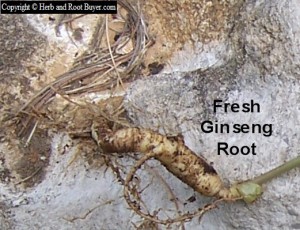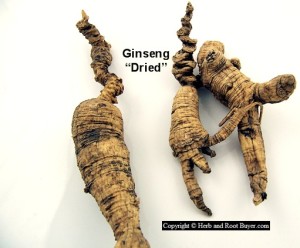Ginseng – Panax quinquefolius
|
Current Demand = GOOD |
Current Market Price = $Market$ |
|
Current Demand = GOOD |
Current Market Price = $Market$ |
|
Current Demand = Normal |
Current Market Price = $Market$ |
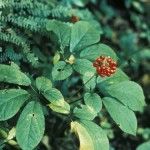 |
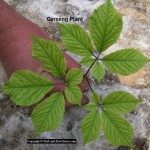 |
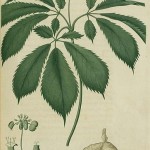 |
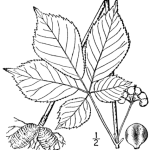 |
Family: Araliaceae
Common Names: Nin-sin, American ginseng, Shang, Sang, Manroot
Description
This is a perennial herbaceous plant that can reach 20 inches with leaves that are whorled. The leaves can reach 10 inches in length and there are usually three leaves. Each leaf is palmate and divided into five toothed leaflets. The flowers have 5 regular parts and are up to .25cm wide.
They are greenish-white and the blooms first appear in the mid spring and continue until mid summer. The flowers are single umbel from the center of the leaves. It has a fruit of bright red berries. In the fall during harvest season, the leaves of ginseng are a brilliant gold color. The root is forked, thick, aromatic and swollen in the middle.
Wild ginseng is ginseng that has not been planted and cultivated domestically, rather it is that which grows naturally and is harvested from wherever it is found to be growing. It is considered to be superior to domestic ginseng by various authorities, and it has been shown to contain higher levels of ginsenoside. Wild ginseng is relatively rare due in large part to habitat loss. (It requires seven years for a ginseng root to reach maturity).
Growing Region
Ginseng can be found in the Eastern half of the U.S. and southeaster Canada. It is common thru-out the Midwest and Appalachia and west to Oklahoma and then north to Minnesota. It is often found in rich moist woods with well drained soil. Ginseng is a hearty herbaceous perennial plant which can often be found growing among goldenseal.
Harvesting/Drying
Part used: root
Ginseng harvest is regulated by the federal government and should only be harvested after the red seed has matured. Be sure to check with your state department of natural resources or department of agriculture for harvesting and selling guidelines. Most states begin harvest season on or after September 1st. Only 19 states permit the harvest of wild ginseng: Alabama, Arkansas, Georgia, Illinois, Indiana, Iowa, Kentucky, Maryland, Minnesota, Missouri, New York, North Carolina, Ohio, Pennsylvania, Tennessee, Vermont, Virginia, West Virginia and Wisconsin. Gather the larger more mature 3 and 4 prong plants leaving plenty of younger plants to seed the area for future harvest. Deer feed heavily on ginseng tops so patches which had once been spotted may not be visible the next time you go back. Also, ginseng can lay dormant for a number of years so you may find ginseng in an area where you have never seen it before. When harvesting ginseng, extreme care should be taken to keep roots and neck in tact. Broken and cut roots can result in lower price at market. With ginseng being such a valuable crop it is becoming more and more important that you take good care of the roots you dig to sustain its value. Properly cleaned in tact roots do bring more money at market than dirty and or broken roots. As mentioned earlier, always follow good stewardship practices.
After harvest, the roots should be gently washed in cold water and foreign material (rocks, dirt and other roots) must be removed. Never soak roots in an attempt to clean them as it not necessary. Never scrub ginseng roots with a brush as ginseng that is scrubbed too clean can hurt the value. Separate the stem from the root where the two meet at ground level. Unless your buyer is purchasing fresh dug roots (which they often do) the clean roots need to be dried. Ginseng should be dried indoors in a well ventilated barn loft or attic to protect from the elements. If natural heat is not available, you may need to add heat to a room (100 degrees maximum) and a fan for continuous airflow. An old window screen or shallow cardboard box does well for drying ginseng. Also, while it is common to thread ginseng on a string to hang and dry most buyers do not recommend this as this practice tends to damage most of the roots. Do not dry ginseng inside of a car or in a dehydrator as it can and often will cook the inside of the root, and render it worthless. The key to drying any root, herb or bark is an even combination of heat and air flow. Never dry in an oven or microwave.
Once your roots are completely dry (gently squeeze the largest root and it should be hard) do not break roots to check for dryness. Ginseng should dry in 6-14 days depending on the size of the roots and the drying conditions. Place dried roots loosely into a cardboard box or paper bag for storage in a dry area until ready to sell or use. Do not store the roots in plastic or it will mold.
Planting/Cultivation
Best grown in moist, fertile, organically rich, medium wet soils in part shade to full shade. Soils should not be allowed to dry out. The plants prefer light, medium, and heavy soils which are acid, neutral and basic located in full shade or semi-shade that is moist. Seed – sow in a shady position in a cold frame preferably as soon as it is ripe, otherwise as soon as the seed is obtained. It can be very slow and erratic to germinate. Prick out the seedlings into individual pots when they are large enough to handle and grow them on in a shady position in the greenhouse or frame for at least their first winter. Make sure the pots are deep enough to accommodate the roots. Plant out into their permanent positions in late summer. Do division of the plants in the spring.
Attributes (Images)
By uwdigitalcollections [CC BY 2.0], via Wikimedia Commons
 Root Buyer
Root Buyer